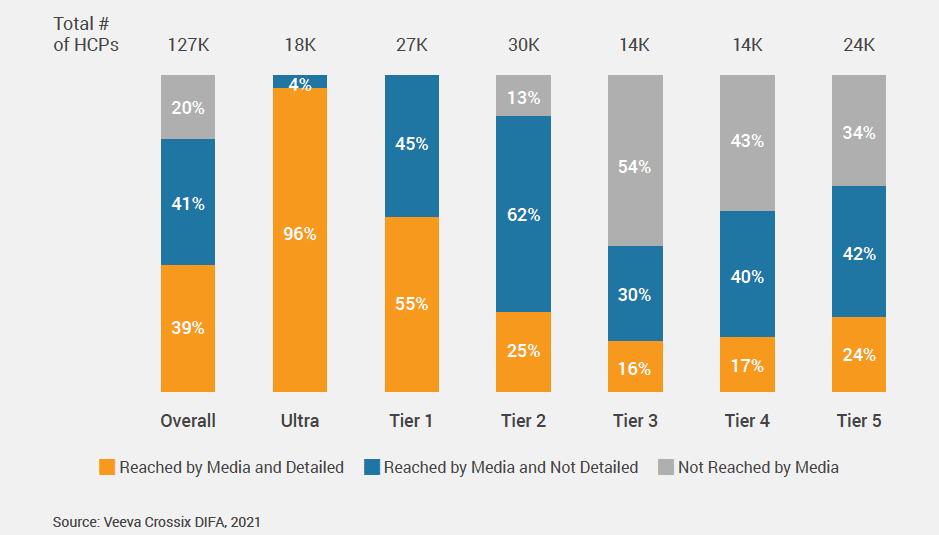With all of the many changes in the world of healthcare, marketing and communication strategies seemingly need to be completely rewritten on an annual basis.
Physicians aren’t as cut off as they were during the height of Covid, but several competing demands are rushing to fill that available time.
Physician Availability
Let’s take a look at some stats around physicians’ availability from the past few years. You’ll see that a lot of these stats reference pharma, but the concept certainly applies to the realm of medtech, as well.
- 64% of healthcare providers agreed they were receiving too much digital communication from pharma companies (2021 source – Accenture).
- 67% agreed they were getting invited to more meetings than they could possibly attend (2021 source – Accenture).
- In one Pharma company’s experience, in-person meetings had declined by 35%. Also, the number of interactions per year were more scarce: only half of the available and willing physicians would meet more than once in a year, and only a quarter would meet four times (2021 source – PharmExec).
- In Europe, 25% of physicians reported they would see sales reps less often than they did in pre-pandemic times, and another 10% reported they never saw reps (2023 source – CMI Media Group via Fierce Pharma).
- Ad spend has been projected to go from $8.6 billion to $15 billion in the time period between 2019 and 2023 (2021 source – Insider Intelligence).
A Closer Look at the Numbers
It seems like healthcare trends and stats need to be completely updated every six months for them to be relevant, so you should definitely take what you see above with a grain of salt. Still, these numbers are good indicators of what’s happening.
All this information illustrates two main concepts:
- Physicians are tough to access, despite the fact that the world has once again opened.
- Healthcare as an industry is spending more than ever to get attention.
What Can You Do?
Well, you can’t go back to your pre-Covid routine. There’s a new minimum for interactions with potential and existing customers.
For this article, I want to specifically focus on how you’re communicating with your current customers. I believe it’s a meaningful investment that can net new business as physicians you know and respect begin to talk with one another and make recommendations for tools.
Meetings Are Back
People were worried in the height of Covid that healthcare meetings would never come back or be the same. Maybe they aren’t the same, but meetings are definitely back. I have a friend in the event production space, and he is plenty busy with pent-up demand for meetings. Brands are spending big to bring people back together.
In fact, we were just at the Shoulder 360 meeting in Miami this past week. It’s a small yet rapidly expanding orthopedic meeting with a passionate base of shoulder and upper extremity surgeons. The treatment space is evolving rapidly from a medical perspective, and there are a lot of great conversations happening around tools and techniques.

While speaking with some of the vendors in attendance, we heard folks commenting about the need to maintain a brand presence to show that you’re definitely in the game. This may not be the best place to find new leads who are ready to purchase, but it gives companies a couple of opportunities:
- Initial demonstration of a device
- Connection with current customers
- Longer conversations with warm leads who weren’t ready for their hospitals to know they were considering working with another implant company
These points came from a small number of vendors, so maybe companies at events should be gaining more from their experiences. I’d love to hear if you’ve had a different kind of trade show experience.
Sales Reps Still Vital
Medtech and pharma leadership may have hoped they could cut back on the expense of sales personnel when everything went remote during the onset of Covid, but reps still matter in a big way. In some cases, they are the literal face of a medtech company.
When it comes to discussions around creating personalized materials for your customers, your reps should be the epitome of this kind of interaction. Ideally, your reps are listening to your customers to hear how their treatment and business needs are transforming. Only then, after taking in all that info would reps make personalized recommendations.
Marketing tools are getting more sophisticated, but we still don’t have the ability to completely replace that sort of face to face interaction.
Coordinating Reps with Digital
Whether you’re attempting to communicate with potential or existing customers, the key here is that you’re coordinated in your approach.
Take a look at what Veeva accomplished with their most important accounts by focusing on ensuring that they achieved coverage:

When it comes to prioritizing your spend, this is a great way to conceptualize your goal. I don’t have any sort of relationship with Veeva, so I’m not sure how they confirmed media reach. Still, the idea is fantastic.
With targeted media spend for physicians getting so pricey, all brands should be prioritizing their intended recipients as much as possible—both in person and digitally. For example, if you could work with your media buyer to target the locations of your top customers, created an email campaign, and gave your sales reps talking points that matched your ads, you could create a much higher likelihood that those critical communication points land at least once—if not multiple times.
The Brand in Every Interaction
Think about all the communication your company sends—not just your polished marketing messages, but every type of administrative email, as well. Your brand most certainly shines through or suffers in every single engagement.
Measure your customer interactions every chance you get. You may have to get creative to capture this data for some of your communication methods. But, you need to know how people are responding so you can keep refining every touchpoint. You can, of course, look at your website analytics, but you should also apply the same (or higher) level of rigor when it comes to any online applications that exist behind a login.
Every brand interaction shapes your relationship with your customer, which presents the opportunity for growth.
Setting the Stage for Word of Mouth Recommendations
How does (positive) word of mouth happen?
It requires having a great product. That’s the bare minimum to get started.
Negative experiences are easily shareable. (We’ll talk about this more in upcoming articles.) But positive experiences don’t spread as easily.
You need a point of differentiation.
You need repetition of your messaging: in trade shows, in online experiences, in your follow-up messaging. Don’t forget, attrition is real, and the competition is fierce.
You need positive, personal relationships with your accounts. This happens through your reps or area directors, and it happens through the plethora of communication and response tools you put at your customers’ disposal (feedback options, troubleshooting guides, chat features, support numbers, etc.).
These relationships provide the opportunity for what marketer Jay Baer calls “talk triggers”: experiences that are literally remarkable (worthy of conversation).
Bonus points if you can get a community of physicians sharing their experiences with one another in a setting you provide. (Here’s an article on physician community to provide some ideas.)
These are all the pieces to generating conversation. You can’t force it, but you can create an experience worthy of discussion.
Michael spends a great deal of time with the healthcare industry both professionally and personally, which gives him the perspective of what stakeholders on either side of the care equation need.
He began coding in 2008 and subsequently shifted his attention entirely to online marketing. Michael completed his MBA in 2018, focusing on the intersection of healthcare and marketing.


